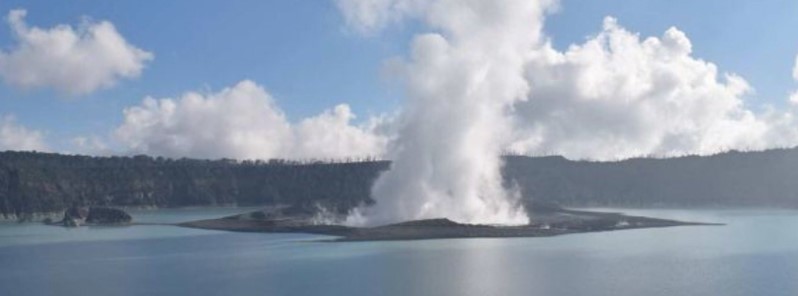Ambae volcano hazards ahead of rainy season, Vanuatu

Eruptive activity at Aoba volcano, also known as Ambae, is continuing in the minor eruption state and the Alert Level for the volcano remains at Level 3, the Vanuatu Meteorology and Geohazards Department reported today and warned about hazards around the volcano ahead of 2017/18 rainy season.
The current activity consists of ongoing small explosions and ejection of hot rocks, similar to what is seen and experienced at Yasur on Tanna Island, continued emission of ash and gas column. The ash and gas column is a typical volcanic hazard (risk) of the current activity that may cause problems to people, crops, animals, and equipment. The impact of ash and gas are often widespread driven from the wind direction. On Ambae Island especially those exposed to trade wind direction (southern and western part of the island) may continue to get ash more often.
Entering the rainy season (November 2017 to April 2018) volcanic ash that has fallen to the ground, high on the volcano, near the active vent will be washed off the volcano, and make muddy floods. This type of event is well known from many volcanoes both in Vanuatu and around the world. Muddy floods will make the streams discolored, change the type of runoff and be more eroding. This event can damage stream and river crossing location such as bridges and fords.
This is a new problem for Ambae but has been seen at Gaua after the eruptions in 2009 – 2010. Gas in a volcanic column will also join with the rain and maybe experienced on the ground as mild acid rain. Acid rain is detected by unusual taste and irritating eyes. If a lot of acid rain occurs there maybe damage crops and water reservoir (such as water tank, water catchment).
It is not possible to stop muddy floods, so people need to be aware, VMGD warns.
The hazards during rainfall may make changes for crossing streams (the sediment in the stream will make water more “heavy” to walk through). Freshwater supplies may be affected, its appearance and taste might change. Freshwater animals such as prawns may also be affected. It can be a problem even if it is dry near the coast, as rain near the summit will start the water flows. This can occur in many/all streams from the summit area (rain high on the island will wash ash off) and some stream flows may be larger than normal.
To minimise the impact of these small muddy floods, people living near creeks and streams may want to clear the channels of debris such as branches, stones etc…. so flood can pass easily. Tie off one end of small bridges so it cannot wash away. Stop using water supplies from streams for cooking and drinking when dirty and flooded. During acid rain, as explained in the last VMGD awareness campaign in mid-October 2017 before Ambaeans repatriation, make sure to remove the water spout from your tanks and wells and avoid collecting this water into the tanks.
It is important people are aware of the possible changes and stay safe. Understanding the hazards will allow people to protect their bridges and water supplies.
Geological summary
Aoba, also known as Ambae, is a massive 2 500 km3 (600 mi3) basaltic shield volcano that is the most voluminous volcano of the New Hebrides archipelago. A pronounced NE-SW-trending rift zone dotted with scoria cones gives the 16 x 38 km (10 x 23.6 miles) island an elongated form.
A broad pyroclastic cone containing three crater lakes is located at the summit of the Hawaiian-style shield volcano within the youngest of at least two nested calderas, the largest of which is 6 km (3.7 miles) in diameter. Post-caldera explosive eruptions formed the summit craters of Lake Voui (also spelled Vui) and Lake Manaro Ngoru about 360 years ago. A tuff cone was constructed within Lake Voui about 60 years later.
The latest known flank eruption, about 300 years ago, destroyed the population of the Nduindui area near the western coast. (GVP)
Featured image: Aoba (Ambae) volcano, Vanuatu. Credit: Vanuatu Red Cross

Commenting rules and guidelines
We value the thoughts and opinions of our readers and welcome healthy discussions on our website. In order to maintain a respectful and positive community, we ask that all commenters follow these rules:
We reserve the right to remove any comments that violate these rules. By commenting on our website, you agree to abide by these guidelines. Thank you for helping to create a positive and welcoming environment for all.